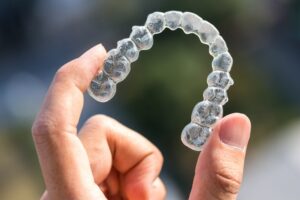Will It Hurt to Have Invisalign Attachments Removed?
June 17, 2025

Invisalign is a popular orthodontic treatment known for being discreet, comfortable, and effective. A key part of what makes Invisalign work so well is the use of attachments, small, tooth-colored bumps that are bonded to your teeth to help the aligners grip and shift them into position more effectively. While these attachments play a vital role during treatment, many patients wonder what to expect when it’s time to have them removed. Specifically, will it hurt?
What Are Invisalign Attachments?
Invisalign attachments (also called buttons) are made of composite resin, the same material used in tooth-colored fillings. They come in various shapes and are placed on specific teeth depending on your treatment plan. Their purpose is to provide extra leverage so the aligners can move your teeth more predictably.
They’re virtually invisible and do not interfere much with daily life, although they can make putting in and taking out your aligners slightly more challenging.
The Removal Process: What to Expect
The good news is that having Invisalign attachments removed is typically a quick and painless process. Your dentist or orthodontist will use a specialized dental tool to gently buff or polish the attachments off your teeth. This tool carefully removes the resin material without harming your enamel.
The procedure usually takes only a few minutes per tooth and does not require any anesthesia or numbing agents. Most people compare the sensation to getting their teeth cleaned – some vibrations or slight pressure, but no actual pain.
Will It Hurt?
In most cases, no, it does not hurt to have Invisalign attachments removed. However, you might experience:
- Minor sensitivity: If you have sensitive teeth, you may notice a little discomfort or cold sensitivity during or shortly after the procedure.
- Vibration sensation: The tool used to remove the attachments may create a buzzing or vibrating feeling, but this is not painful.
- Mild gum irritation: If the attachments are close to the gumline, you might feel slight irritation during the removal process, but this usually resolves quickly.
It’s important to remember that every patient is different. If you have concerns about sensitivity or anxiety during dental procedures, talk to your provider beforehand. They can take steps to make you more comfortable.
Aftercare and What Comes Next
Once the attachments are removed, your dentist will likely polish the surface of your teeth to make sure there is no residue left behind. You may feel that your teeth are smoother afterward.
In some cases, patients transition into a retainer phase after the attachments come off to help maintain the new alignment. It’s important to follow your dentist’s instructions to prevent your teeth from shifting back.
Having your Invisalign attachments removed is a normal and essential part of completing your orthodontic journey. The process is typically painless and quick, and any discomfort you feel should be minimal and short-lived. If you’re concerned, communicate with your provider.
About the Author
Dr. Bradford Plasha graduated from the Rutgers School of Dental Medicine, where he also completed an externship in prosthodontics. He has done extensive training in dental implants and is a Fellow of the International Dental Implant Association. Dr. Plasha has stayed current in the field through ongoing education efforts and professional memberships in organizations like the American Dental Association and the Pennsylvania Dental Association. If you’d like to get Invisalign treatment to straighten your smile, our team of professionals would be glad to serve you. Schedule your appointment online or call (484) 854-6900.
No Comments
No comments yet.
RSS feed for comments on this post.
Sorry, the comment form is closed at this time.
